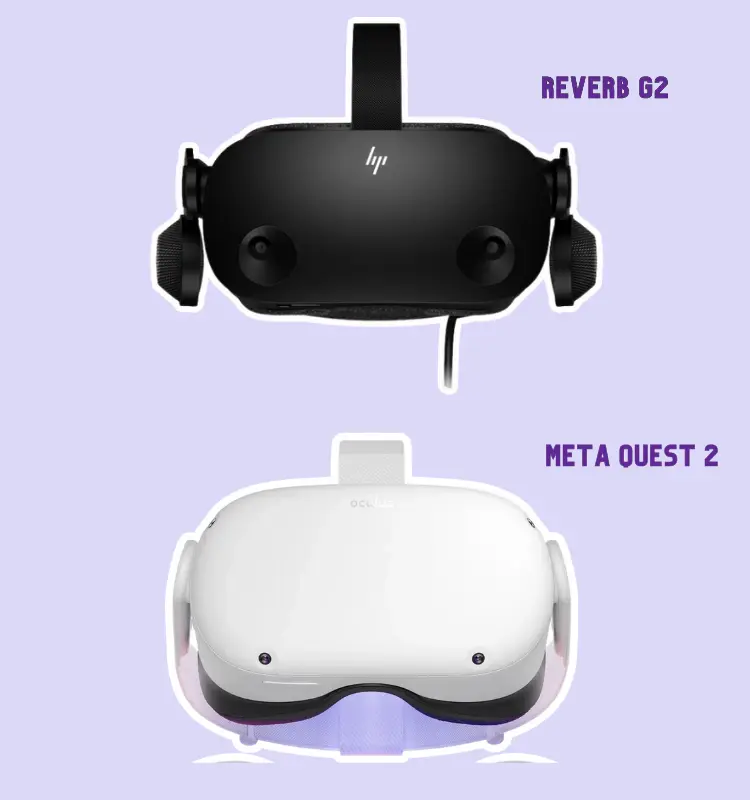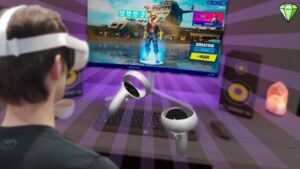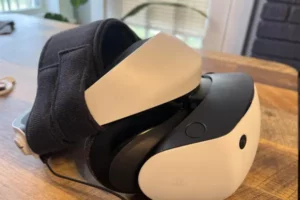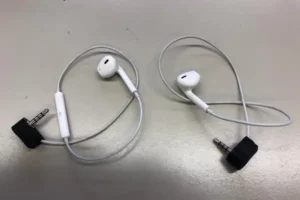The virtual reality industry is witnessing a titanic battle between two major tech firms: who can offer the best user experience? The Oculus Meta Quest 2 headset is the company’s latest and greatest. However, on the other hand, there’s the HP Reverb G2, a VR headset with lofty ambitions. Get your virtual reality headsets ready for the final showdown between the two top contenders.
Let’s compare these two big names here:

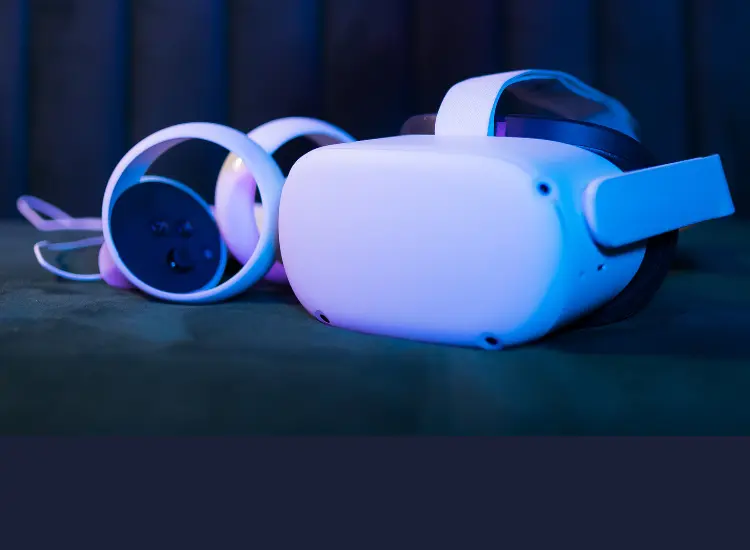
Comparison Table: Meta Quest 2 Vs Reverb G2
| HP Reverb G2 | Meta Quest 2 | |
| Dimensions | 74.9 x 185.9 x 84 mm | 191.5 mm x 102 mm x 142.5 mm |
| Display | 2 x 2.89” LCD panels (RGB sub-pixels) | Single 5.46-inch fast switch LCD (RGB stripe) |
| Resolution | 2160 x 2160 per eye | 1832 x 1920 per eye |
| Refresh Rate | 90 Hz | 72 Hz, 90 Hz, 120 Hz variable |
| Lenses | Fresnel-Aspherical | Fresnel |
| FOV (Horizontal/Vertical) | 98°/112° | 89°/112° |
| Pixels Per (Horizontal) Degree (PPD) | 22.04 | 20.58 |
| Weight | 550g (without cable) | 503g (Elite strap with battery adds 319g) |
| Tracking | 6 DoF dual controllers tracked by HMD | 6 DoF dual controllers tracked by HMD. Basic hand tracking. |
| IPD Adjustment | Smooth, manual IPD adjustment (60 – 68mm) | 3 manual IPD settings (58, 63, 68 mm) |
| Sound | Off ear speakers | Integrated stereo speakers |
| Headstrap | Front-hinged, rigid head strap, adjustable with velcro straps | Soft, material head strap (optional elite strap available) |
| Price | $599 (Currently on offer for $399) | $399 for 128GB/$499 for 256GB |

Comparision: Apple Vision Pro vs Quest 3
Overview of These Two Gigantic VR Headsets
In conclusion, the HP Reverb G2 VR Headset and the Meta Quest 2 Headset are both excellent virtual reality headsets. Both have the potential to completely immerse the user with high-quality graphics and sound. The Meta Quest 2 Headset is a lightweight and convenient headset that features in-line volume and mute controls and headphones. It has a high resolution, a wide viewing angle, and is glasses-compatible. The HP Reverb G2 VR Headset has two 2.89-inch LCD panels capable of a combined resolution of 4K and features inside-out tracking. No glasses can fit, although the in-ear headphones are handy. Both headsets are comfortable and entertaining for VR gaming and other activities, but the HP Reverb G2 has better resolution panels and inside-out tracking.
Comparison Based on Design
Virtual reality gaming headsets includes the HP Reverb G2 and the Meta Quest 2 by Metaverse. Since its introduction in October 2020, the Meta Quest 2 is a newer device than the HP Reverb G2, which came out in August of the same year.
The Meta Quest 2’s display resolution is 2160 x 2160 per eye, making it superior to the HP Reverb G2’s resolution of 2160 x 2160. The Meta Quest 2’s field of view is 110 degrees, which is more than the 114 degrees offered by the HP Reverb G2.
The HP Reverb G2 includes a 3.5mm jack and a USB connector, but the Meta Quest 2 has built-in speakers. The HP Reverb G2 lacks a microphone, but the Meta Quest 2 comes with one. Both the Meta Quest 2 and the HP Reverb G2 include adjustable head straps and ergonomic designs, with the Meta Quest 2 coming in at 400g and the HP Reverb G2 at 550g, respectively.
When compared to the HP Reverb G2, the Meta Quest 2 headset is more affordable. Both the HP Reverb G2 and the Meta Quest 2 are solid gaming headphones, although the latter has a few more bells and whistles.
Read! Meta Quest Pro Vs Pico 4
Comparison Based on Video Playback Quality
It’s debatable whether or not the Meta Quest 2’s visual quality is superior to that of the HP Reverb G2 VR headset. The resolution of both the HP Reverb G2 and the Meta Quest 2 is 2160 by 2160 for each eye. The field of view in both headsets is 110 degrees, and the refresh rate is 90 hertz. The increased resolution of Meta Quest 2’s screens makes everything easier to read. Some have claimed that the visual quality on the HP Reverb G2’s LCD screen is superior.
The HP Reverb G2 has an adjustable interpupillary distance that may make wearing glasses more comfortable. The choice between the two headphones ultimately comes down to individual preference.
Possession of Effortless Command
Virtual reality headsets have become increasingly popular, with some of the most well-known models including the HP Reverb G2 VR Headset and the Meta Quest 2 Headset. Both headsets have excellent integrated control systems, making it simple to move around in a virtual environment. The Meta Quest 2 Headset is comfortable to wear and detects movement precisely. The HP Reverb G2 VR Headset’s advanced lens system and user-friendly controls make for a comfortable and immersive experience. Both headsets offer a wide variety of features and capabilities, so users should take their personal needs into account when making a choice.
Read! Meta Quest 2 vs HTC Vive
Prices
Two of the most well-known VR headsets are the Meta Quest 2 Headset and the HP Reverb G2 VR Headset. They’re both high-quality and immersive, yet their retail prices are different. Prices for virtual reality headsets range from about $400 for the Meta Quest 2 to about $600 for the HP Reverb G2 VR Headset. Both headsets have benefits that can appeal to certain users; picking one over the other comes down to price and personal preference.
Ease of Use
There is no discomfort associated with using the Meta Quest 2 with Elite Strap with Battery. The standard Quest 2 strap is not particularly pleasant to wear, but the Elite Strap with Battery is perfectly sized and really snug.
The Quest 2 is not nearly as comfy as the Reverb G2 when using the factory-default fabric for the head strap. It was comfortable enough that I could wear it for a few hours, but it doesn’t compare to the Reverb G2 in terms of wearability. The Elite Strap with Battery that I bought for my Quest 2 was a huge upgrade in terms of wearability.
You can choose between just the Elite Strap and the Elite Strap with Battery. The Elite strap is much more comfortable because it is firm and wraps around your head to keep the headset in place. The Elite’s strap has an adjustment knob at the back, so you can ratchet the headset to the perfect fit in a matter of seconds. Even though it is not as plush and cushioned as the Reverb G2, the Elite Strap’s rubberized back provides a secure and snug fit for your head.
The Elite Strap with Battery is the most comfortable accessory for the Quest 2, since it distributes the weight of the headset evenly and allows for hours of wear without discomfort thanks to the Elite strap’s soft padding and the headset’s adjustable length. With this arrangement, I am able to play the Quest 2 for long periods of time without getting tired of it, and the nearly doubled battery life means that I rarely have to stop playing before I am ready for a break.
In conclusion, the Elite Strap with Battery is an absolute must-have if you plan on purchasing a Quest 2. The Quest 2’s price goes up by $119 because of this, making it more expensive than competing models based on current sales and the specific Quest 2 variant chosen.
More Related! Meta Quest 3 Vs Pico 4
Luminous Flow
Light seepage around the nostril area of the facial interface while wearing the Meta Quest 2. Light leaks quite a little around the nasal area when you’re wearing the Quest 2.
Light leaks significantly around the nose and into the lower half of your field of vision while using the basic Quest 2 facial interface. Using the Elite Strap does not help significantly. Depending on your personal choice, you may wish to invest in a third-party facial interface that can mitigate or eliminate this light leak.
When I use the HP reverb G2, however, there is absolutely no light leak. The facial interface clamps down tight on my face, sealing me off from the world. This has a fantastic feel and vastly helps the immersiveness of a wide variety of games. When playing a sitting simulation game, this is especially crucial, as any distraction might ruin the experience.
The Reverb G2 and Quest 2 controllers are aesthetically similar; they both have ergonomic handles, a standard button layout, and a tracking ring on top. The Quest 2 controller is much smaller than the HP Reverb G2 controller, but it is heavier and more solidly built, and it is also slightly more comfortable to handle.
The Reverb G2 controller’s primary weakness is its need for batteries. Rechargeable batteries, in particular, are known to be somewhat finicky. Most standard, non-rechargeable AA batteries operate at 1.5V, making them a suitable power source for the Reverb G2 controllers. But since most rechargeable batteries only have a voltage of 1.2V, your Reverb G2 will quickly report a low controller battery when you use them.
Although I do use 1.2V rechargeable batteries in my Reverb G2’s controllers, this problem has me swapping them out more frequently than I’d like. In comparison, the Quest 2’s controllers just require a single AA battery and provide an exceptionally long battery life.
It’s also worth noting that some Quest 2 owners have complained of controller stick drift, a problem shared by all thumbstick controllers. From what I can tell, this isn’t any more prevalent than it is with other types of controllers, and there are a few things you can try to do to repair it on your own.
The Quest 2 controllers are slightly more pleasant to operate, but both the Reverb G2 and Quest 2 controllers do their jobs well.
The sweet spot is the focal point of a pair of glasses, where vision is the sharpest and most comfortable for the wearer. More of your visual field will be in focus regardless of how you position your eyes in front of the lenses if the sweet spot is greater.
There have been complaints about the HP Reverb G2 headset’s narrow sweet spot, but I didn’t notice a major difference between the Quest 2 and the Reverb G2. Informal tests I’ve performed on the sweet spot of the Quest 2 and the Reverb G2 lenses indicate very little distinction between them.
However, you should place each VR goggle on your face so that your eyes are directly in front of the lenses. This could change in the future as technology and lenses used in VR headsets advance, but for now, fresnel lenses mean just a tiny portion of the display will be in sharp focus.
Related! Meta Quest 3 Vs Vive XR Elite
Condensation on the Lens
Lens fogging is a major problem with virtual reality headsets, as I said before, although its severity varies from headset to headset. This is because the lenses of your virtual reality headset are cold, causing moisture in the air to condense.
In my experience, the lenses on my Quest 2 rarely fog up to the point that I have to put it down and clean it. Because the facial interface doesn’t create a hermetic seal around your face, air can flow freely about your head, keeping the environment dry and cool, and preventing the kind of conditions that produce lens fog.
This may seem like a minor issue, but it can become really frustrating if your glasses consistently fog up, especially while engaging in more physically taxing games. There are a several methods for keeping VR lenses from misting up, but none of them are foolproof.
Turning on my Reverb G2 five to ten minutes before I play helps warm up the lenses, reducing the amount of lens fog, but it’s still a bigger problem than with my Quest 2.
The Final Words
There are a wide variety of virtual reality headsets out there to choose from. The HP Reverb G2 and the Meta Quest 2 are two of the most well-known models. The Meta Quest 2 VR headset is a portable, stand-alone device with built-in wireless connectivity and motion tracking. It can refresh at 90 hertz and has a resolution of 1832 by 1920 per eye. The headset also has hand-tracking technology, which eliminates the need for controls while interacting with virtual environments.
